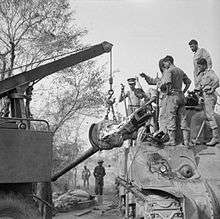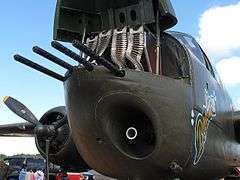75 mm Gun M2/M3/M6


The US 75 mm gun tank gun M2 and the later M3 were the standard American tank guns of the Second World War, used primarily on the two main American medium tanks of the war, the M3 Lee (M2 or M3 gun) and the M4 Sherman (M3 gun)
The lightweight M6 and M5 variants were developed to equip the M24 Chaffee and the B-25 Mitchell bomber respectively. The M3 was also used on the prototype M7 Medium Tank platform.
History

The 75 mm tank gun has its origins in the famous French Canon de 75 modèle 1897 field gun of World War I fame, which was also adopted by the United States and used well into World War II as the 75 mm M1897 field gun. The tank and field guns both fired the same range of 75x350R ammunition. The primary round was the 6.76 kg (14.9 lb) M48 High Explosive round, which travelled at 625 m/s (2,050 ft/s) and contained 1.5 pounds (680g) of TNT filling (2845 kilojoules of explosive energy) and a choice of fuse; the Super Quick (SQ) and the Delay (PD), which had delays of 0.05 and 0.15 seconds respectively. SQ was the standard setting, with PD used against structures, gun positions or lightly protected vehicles. The field gun origins of the ordnance and ammunition ensured that the M2/3/6 series HE round was highly effective for its caliber. The M48 was available in two versions, standard and supercharge, which had an increased propellent charge for greater muzzle velocity (1,885 ft/s (575 m/s) vs. 1,470 ft/s (450 m/s)) and range (2,300 yards greater).
Other important rounds fired by the 75 mm tank guns included the T30 canister shot for use against troops in the open at short range. This, which was essentially a giant shotgun shell full of large numbers of steel balls, was used primarily in the Pacific. There was also the M88 base-ejecting smoke round and the M89 white phosphorus (WP or "Willy Pete") round, which proved highly effective in the bocage fighting around Normandy. Finally, there were two different armor-piercing rounds.
The first armor-piercing round was the 6.32 kg (13.9 lb) M72 AP-T, a plain uncapped AP round whose performance dropped off as range increased due to poor aerodynamics. The M72 was replaced by the 6.63 kg (14.62 lb) M61 and later the improved M61A1 APC Shell. This was actually an HE/APC-T type or rather an Armor Piercing Capped with Tracer filled with a small quantity of High Explosive. The aerodynamic ballistic cap acted as a windscreen and improved ballistic performance, maintained velocity, and retained penetration at longer ranges. The armor-piercing cap, made of a softer metal, helped to prevent shell shatter at higher velocities and against sloped and "face-hardened" armor(FHA). Once the projectile had penetrated the target, a small explosive charge at the base of the shell would detonate shattering the shell, and increasing damage inside the enemy vehicle. The tracer helped in the aiming of a second shot. In practice, the majority of M61 rounds were shipped without the explosive filler. The M61 had a muzzle velocity of 617 m/s (2024.28 ft/s) and was credited with the ability to penetrate 3.3 inches (84 mm) of Rolled Homogeneous Armor plate (0° from vertical) at 500 yards range, which was a quite acceptable performance by the standards of 1942. This ammunition type proved lethal to the Panzer III and IV (up to Ausf. F2), as these tanks were protected by a maximum of 50mm of FHA with little slope, which the 75 mm M3 was capable of penetrating from 1500 m.[1] However, in March 1942, the germans introduced the Ausf. G verson of the Panzer IV, which produced through to June 1943 and was armed with the 48-calibre barrel length KwK 40 gun, and its frontal hull armour increased up to 80 mm - however, its turret and gun mantlet retained their 50 mm thickness. This was somewhat compensated by the M4 Sherman's improved armor over the earlier M3 Lee making up for the 75 mm M3's diminishing battlefield dominance; Wa Pruef 1 estimated that the M4's glacis was impenetrable to the KwK 40 when standing at a 30-degree side angle, while the 75 mm M3 could penetrate the Ausf G's hull from 100 m in the same situation.[2]
British tanks in the early years of World War II relied on high-velocity, smaller-calibre anti-tank guns, such as the Ordnance QF 2 pounder and Ordnance QF 6 pounder, for their primary armament. As tank guns, these had the great disadvantage of either not having a truly effective High Explosive round or not even having a HE round at all. After experiencing the effectiveness of the American 75 mm tank guns in the infantry support role, The British opted to adopt the American caliber and ammunition by the expedient of boring-out the 6 pounder tank gun to make the Ordnance QF 75 mm. By 1944, this had become the standard British tank gun, equipping the Cromwell tank and Churchill tank for the campaigns in northwest Europe.
Variants
M2
Used on the early M3 Lee.
- Barrel length: 31 Caliber
- Muzzle velocity: 588 m/s (1,929 ft/s) with M72 AP shell
- Shell weight (M72 AP): 6.32 kg (14 lbs)
- Armour penetration (M72 AP shell, 100 m, at 30 degrees from vertical): 64 mm of face-hardened (FHA) armour or 76 mm of rolled homogeneous (RHA) armour
M3
Longer derivative of the M2. Equipped American and British vehicles such as the M4 Sherman, the later models of the M3 Lee and the Churchill III/IV (scavenged from General Sherman tanks in the North African theatre). The US Army also experimented with mounting the M3 on various wheeled carriages for use as anti-tank gun, but the program was cancelled due to a lack of requirement.[3]
- Barrel length: 40(37.5) calibres (3 m)
- Muzzle velocity: 619 m/s (2,031 ft/s) with M72 AP shell
- Shell weight (M72 AP): 6.32 kg (14 lbs)
- Armour penetration (M72 AP shell, 100 m, at 30 degrees from vertical): 72 mm of FHA armour or 88 mm of RHA armour
- Muzzle velocity: 617 m/s (2,024 ft/s) with M61 APC shell
- Shell weight (M61 APC): 6.63 kg (14.62 lbs)
- Armour penetration (M61 APC shell, 100 m, at 30 degrees from vertical): 77 mm of FHA armour or 76 mm of RHA armour
M4
The 75 mm aircraft gun M4 is a modification of the M3 gun found in medium tanks. It differs from the M3 gun, only in having a seat for the spline machined in the tube. It was mounted on the M6 mount.
T13E1 / M5
A lightweight version of the M3 with a lighter thin-walled barrel and a different recoil mechanism that was used in the B-25H Mitchell bomber. It uses the same ammunition and has the same ballistics as the M3.
M6
A version derived from the T13E1 for the M24 Chaffee.
- Barrel length: 39 calibres (2,92 m)
- Muzzle velocity: 619 m/s (2,031 ft/s) with M72 AP shell
- Shell weight (M72 AP): 6.32 kg (14 lbs)
- Armour penetration (M72 AP shell, 100 m, at 30 degrees from vertical): 72 mm of FHA armour or 88 mm of RHA armour
- Muzzle velocity: 617 m/s (2,024 ft/s) with M61 APC shell
- Shell weight (M61 APC): 6.63 kg (14.62 lbs)
- Armour penetration (M61 APC shell, 100 m, at 30 degrees from vertical): 77 mm of FHA armour or 76 mm of RHA armour
Penetration comparison
| Gun type | Ammunition type | Muzzle velocity (m/s) | Penetration (mm) | ||||||||||
|---|---|---|---|---|---|---|---|---|---|---|---|---|---|
| 100 m | 250 m | 500 m | 750 m | 1000 m | 1250 m | 1500 m | 1750 m | 2000 m | 2500 m | 3000 m | |||
| 75mm/L31 (M2) | M61 | 563 m/s (1,850 ft/s) | 92 | 89 | 84 | 79 | 75 | 71 | 67 | 63 | 59 | 53 | 47 |
| 75mm/L31 (M2) | M72 | 563 m/s (1,850 ft/s) | 95 | 90 | 81 | 73 | 66 | 60 | 54 | 49 | 45 | 36 | 30 |
| 75mm/L40 (M3/6) | M61 | 618 m/s (2,030 ft/s) | 102 | 99 | 95 | 90 | 86 | 82 | 79 | 75 | 72 | 65 | 60 |
| 75mm/L40 (M3/6) | M72 | 618 m/s (2,030 ft/s) | 109 | 102 | 92 | 84 | 76 | 68 | 62 | 56 | 51 | 41 | 34 |
See also
Weapons of comparable role, performance and era
- Ordnance QF 75 mm : contemporary British tank gun
- 7.5 cm KwK 40 : contemporary German tank gun
- F-34 tank gun : contemporary Soviet tank gun
Notes
- ↑ Jentz, Thomas; Doyle, Hilary (2001). Panzerkampfwagen IV Ausf. G, H and J 1942-45. Osprey Publishing. pp. 20–21. ISBN 1841761826.
- ↑ Jentz, Thomas; Doyle, Hilary (2001). Panzerkampfwagen IV Ausf. G, H and J 1942-45. Osprey Publishing. pp. 20–21. ISBN 1841761826.
- ↑ Zaloga, Delf - US Anti-tank Artillery 1941-45, p 8-9
- ↑ Bird, Lorrin Rexford; Livingston, Robert D. (2001). WWII Ballistics: Armor and Gunnery. Overmatch Press. pp. 62–63.
References
- Zaloga, Steven J., Brian Delf - US Anti-tank Artillery 1941-45 (2005) Osprey Publishing (New Vanguard 107), ISBN 1-84176-690-9.
- TM 9-2800 Standard Artillery and Fire Control Material (dated February 1944)
External links
| Wikimedia Commons has media related to 75 mm Gun M2/M3/M6. |
- Armor penetration table of US 75 mm M3 L/40 guns (search for Intelligence then Text Database of Penetration Data and select US guns)


